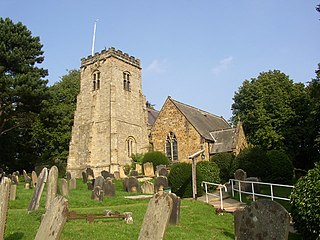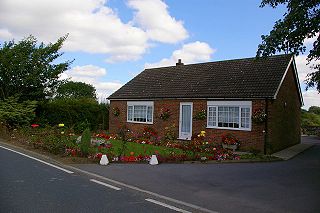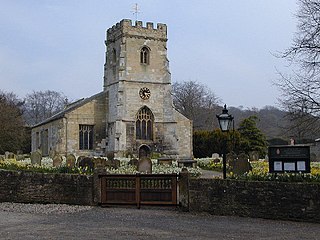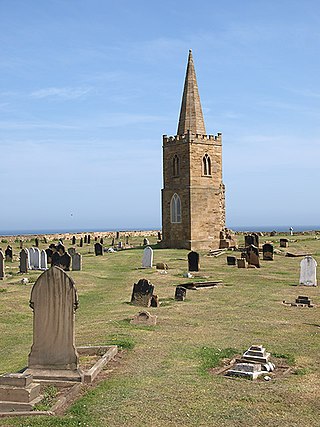
Tadcaster is a market town and civil parish in North Yorkshire, England, 15 miles (24 km) north-east of Leeds and 10 miles (16 km) south-west of York. Its historical importance from Roman times onward was largely as the lowest road crossing-point on the River Wharfe until the construction of the A64 Tadcaster by-pass some 660 yards (600 m) to the south, in 1978. There are two rail crossings downstream of the town before the Wharfe joins the River Ouse near Cawood.

Scarborough and Whitby is a constituency in North Yorkshire represented in the House of Commons of the UK Parliament since 2005 by Robert Goodwill, a Conservative.

Austwick is a village and civil parish in North Yorkshire, England, about 5 miles (8 km) north-west of Settle. The village is on the edge of the Yorkshire Dales National Park.

Scalby, a village on the north edge of Scarborough, North Yorkshire, England, is part of the civil parish of Newby and Scalby. From 1902 to 1974, Scalby was an urban district in the North Riding of Yorkshire.

Scalby is a hamlet in the civil parish of Gilberdyke, in the East Riding of Yorkshire, England. It is situated approximately 7 miles (11 km) west of Brough and 7 miles (11 km) north-east of Goole. It lies on the B1230 road.

William Henry Forester Denison, 1st Earl of Londesborough, known as The Lord Londesborough from 1860 to 1887, was a British peer and Liberal politician. He was also one of the main founders of Scarborough FC.

Settrington is a village and civil parish in North Yorkshire, England, about 3 miles (5 km) east of Malton. It was historically part of the East Riding of Yorkshire until 1974 and part of the Ryedale district from 1974 until 2023.

Flixton is a village in North Yorkshire, England. Until 1974 the village lay in the historic county boundaries of the East Riding of Yorkshire and from 1974 to 2023 it was part of the Borough of Scarborough. There is a public house, the Foxhound Inn.

Hawsker-cum-Stainsacre is a civil parish in the former Scarborough district of North Yorkshire, England. The population of the parish was listed as being 710 at the 2021 Census.

The Sea Cut (Scalby Beck) is a small river that enters the North Sea at Scalby Mills, Scarborough, North Yorkshire, England. The beck is fed from local streams in Scalby, Newby and Burniston and other watercourses draining off the nearby hills. It is also a bypass channel for the upper reaches of the River Derwent when it is under flood conditions.

The Church of St Oswald, Filey, is a parish church in the North Yorkshire town of Filey, England. The church dates from the 12th and 13th centuries, with some embattlements added in the 15th century. The building is now grade I listed and was described by Pevsner as "easily the finest church in the north-east corner of the East Riding".

St Germain's Churchyard is a large cemetery overlooking the North Sea at Marske-by-the-Sea, North Yorkshire, England. Its church tower is a grade II listed structure at the midpoint to the yard and a landmark for sailors out on the sea. It is a remnant of a demolished church, services at St Germain's were replaced in 1876 by St Mark's.

The Church of All Saints, is the church for the village and parish of Skipsea, in the East Riding of Yorkshire, England. The church dates back to the late 11th/early 12th century and was the religious house tied to Skipsea Castle, which lay just to the west in Skipsea Brough. A causeway, to the north of the church, used to link it with the castle motte across what was Skipsea Bail Mere. The village continued developing long after the castle had been demolished c. 1221, and the church became the house of worship for Skipsea.

Ulshaw Bridge is a hamlet on the River Ure, near to Middleham, in North Yorkshire, England. The hamlet derives its name partly from the Medieval stone bridge which spans the River Ure to the immediate south of the hamlet. Ulshaw Bridge is 2.5 miles (4 km) west of Thornton Steward, and 1.25 miles (2 km) east of Middleham.

Thirsk Castle was a defensive Medieval castle in the town of Thirsk, in North Yorkshire, England. The castle was one of three held by the de Mowbray family in Yorkshire.

Raw is a hamlet in the Borough of Scarborough of North Yorkshire, England, near to the villages of Fylingthorpe, Robin Hood's Bay, and Hawsker. The hamlet is mostly agricultural in nature and it lies 0.5-mile (0.8 km) north-west of Fylingthorpe, 4.5 miles (7.2 km) south-east of Whitby, and due east of the A171 road.

Henderskelfe is a civil parish in North Yorkshire, England. The parish does not contain any villages, though it is named after a previous settlement and castle which occupied the land on which Castle Howard is now built. Historically the area was a township in the ecclesiastical parish of Bulmer, however it has been its own civil parish since 1866.

The Church of the Ascension is an Anglican church in the village of Whixley, North Yorkshire, England. Whilst the Domesday Book entry for Whixley mentions the presence of a church, the main fabric of the existing church dates to the 14th century. Up until it was renovated in the 19th century, it was dedicated to St James, but was rededicated as the Church of the Ascension, and it is now a grade II* listed building. Nikolaus Pevsner notes that it is unusual for a village church to be composed of mostly the same style of architecture (Decorated).

Falsgrave is an area of Scarborough in North Yorkshire, England. The settlement pre-dates the Domesday Book survey and was the manor which Scarborough belonged to. Gradually the settlements importance inverted, the area now a south west continuation of shops from the town centre street of Westborough. Parts of the area were designated as a conservation area in 1985. It is also where the A170 and A171 roads meet.

Saxton with Scarthingwell is a civil parish just south of Tadcaster in North Yorkshire, England. The parish contains the villages of Saxton and Scarthingwell, with two churches and the remains of a castle. Historically the area was a township, however it has been its own civil parish since 1866. Although the main part of the Battle of Towton was fought to the north out of the parish, some of the dead were interred in the parish, and at least one minor skirmish was fought within the parish boundaries.





















